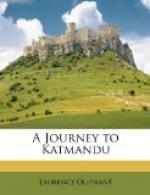A small stream divides the Company’s from the Nepaulese dominions, and on crossing it the change of government was at once obvious. The villages looked more wretched, the people more dirty, the country was almost totally uncultivated, and nearly all traces of roads disappeared as we traversed the green sward of the Terai of Nepaul, scattered over which were large herds of cattle, grazing on the short grass, which extended in all directions over the vast expanse of flat country.
This province is governed by Krishna Bahadoor, a younger brother of the prime minister, an active and energetic officer. Any complaint of the peasantry is in the first instance brought to his notice, and referred by him to his brother, if his decision does not give satisfaction. His subordinates are a sirdar, or judge, and several subahs, or collectors.
The Terai is a long narrow strip of territory, extending for three hundred miles along the northern frontier of British India, and is about twenty miles in breadth. The whole tract is a dead level. For the first ten miles after crossing the frontier the country is used chiefly for grazing by the inhabitants of the adjoining British provinces, who drive thousands of cattle across the border, paying a considerable revenue to the Nepaul government for the privilege of so doing.
Ten miles from the frontier commences the great saul forest, which is also ten miles in breadth. It is composed almost entirely of the valuable saul-tree, and a great quantity of timber is annually exported to Calcutta down the Gandaki, which is navigable to the foot of the Cheriagotty hills. The licence to fell the saul timber is confined exclusively to Nepaul merchants, and the payment demanded by Government for such permission is so enormous that the trade is not very profitable.
The principal sources of revenue derived from this district are the land-tax and the receipts from the sale of licences for felling timber and for grazing cattle. The large amount thus received, together with the number of elephants which are annually caught in the great forest, renders the Terai a most valuable appendage to the Nepaul dominions.
It is, however, entirely owing to the excellent management of Jung that the revenue of the Terai is now so considerable. In 1816 this province did not yield more than one-tenth its present revenue, which is now computed to amount to fifty lacs (500,000 pounds). Still the Terai might be made yet more profitable. At present no use whatever is made of the hides and horns of the hundreds of head of cattle that die daily in this district, which are left to rot on the carcases of the beasts. It would remain to be proved however whether, even if permission were granted by the Nepaul Government, any would be found possessing the capital or enterprise to engage in a speculation which would, unquestionably, ensure a handsome return.




